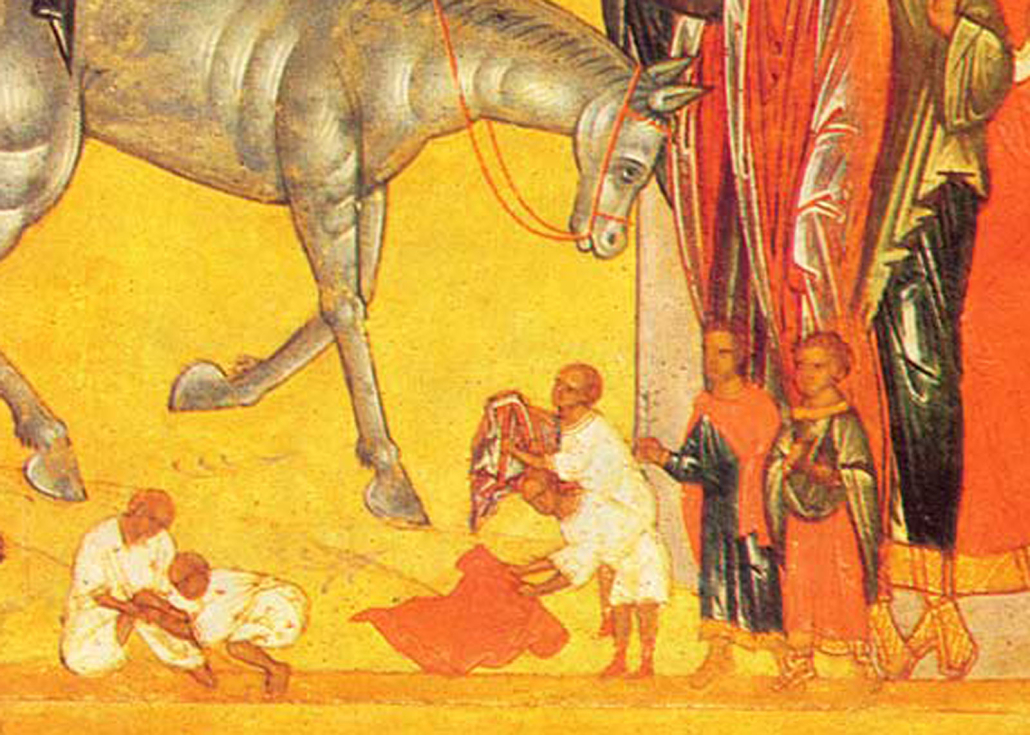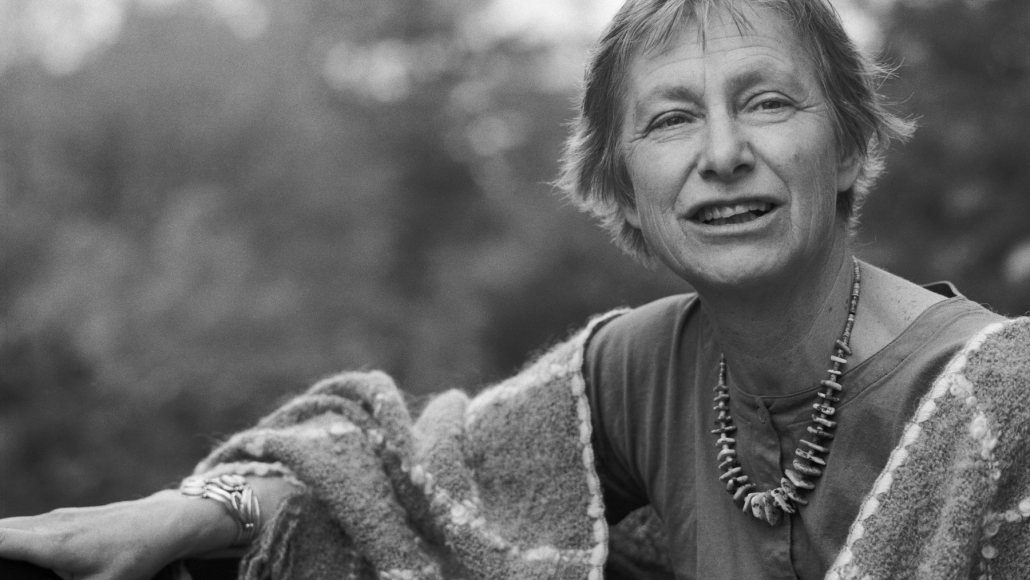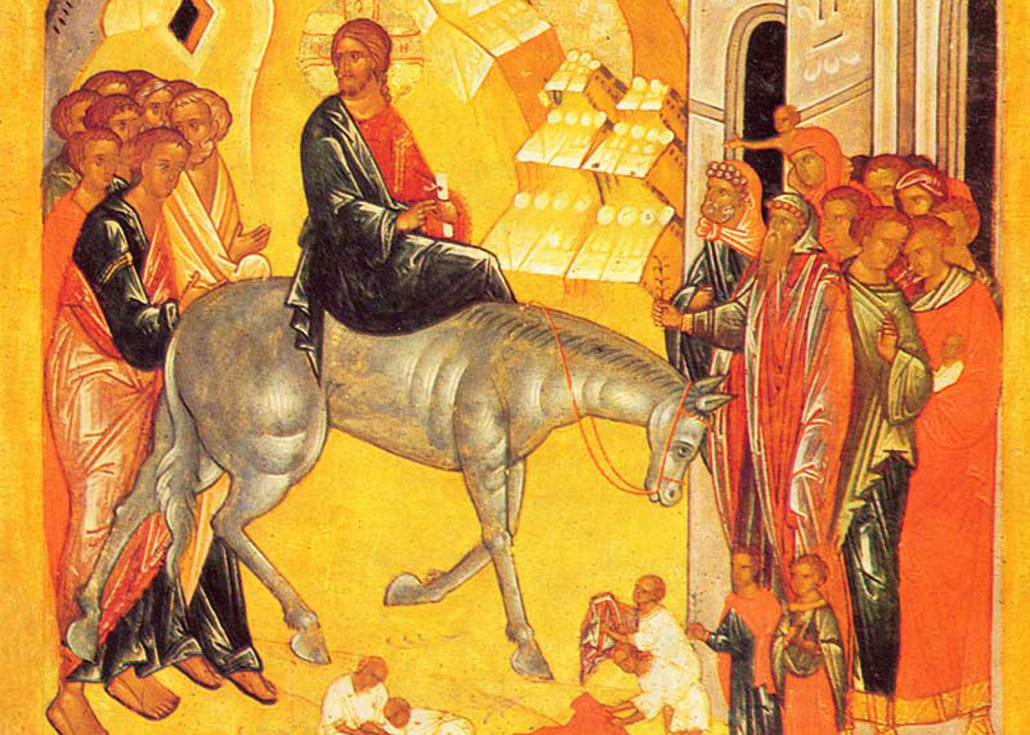Image: Orthodox Icon of the Entry into Jerusalem (detail).
‘Growing into resistance’
Andrew Collis
Palm Sunday, Year B
Psalm 118; Mark 11:1-11
Our Orthodox icon for today is called Entry into Jerusalem. Jesus is depicted at the centre, sitting upon a donkey. His invisible glory is represented by a halo and the scroll in his hand means Holy Wisdom. To the left is the Mount of Olives and to the right is the city.
Behind Jesus, the apostles follow, headed by Peter and John – both described by early commentators as “pillars of the church”.
The apostles are shown in conversation, their expressions a mix of wonder and apprehension – they had already shown consternation at Jesus’ insistence on returning to Judea (Mark 10:32).
Are they perplexed at his choice of animal?
Jesus is shown turning back to the apostles as if exhorting them to continue.
Children are breaking off branches from the palms (some icons depict willows or other foliage), while others are laying garments before the donkey.
In many icons the children are revealed to be wearing white robes beneath their outer garments, emphasising their purity of heart.
The didactic function of the images reflects ancient homilies, which link the event with the celebration, and the rituals of the celebration with our own lives.
From St Andrew of Crete’s seventh-century homily for Palm Sunday:
“Let us go together to meet Christ on the Mount of Olives. Today he returns from Bethany and proceeds of his own free will toward his holy and blessed passion, to consummate the mystery of our salvation.
“Let us run to accompany him as he hastens toward his passion, and imitate those who met him then, not by covering his path with garments, olive branches or palms, but by doing all we can to prostrate ourselves before him by being humble and by trying to live as he would wish. Then we shall be able to receive the Word at his coming, and God, whom no limits can contain, will be within us.”
“Trying to live as he would wish” … a succinct description of contemporary Palm Sunday marches the world over …
A small but significant detail first appears from the 14th century.

Two children are seated in the foreground, one helping to remove a thorn from the foot of the other. These are children who have climbed the tree to gather palms. The thorns (and, of course, we imagine the crown of thorns too) represent the difficulties on the way that leads from the Mount of Olives to Jerusalem; through the wilderness of Christ-like struggle to the New Jerusalem or heaven on earth.
As followers of Jesus and children of God we need to help each other on the way. There will be thorns, dangers, missteps, injuries, as well as times for rest and recovery.
Our Lenten nomination process – amid some difficulties, worries, discomfort – again reveals loving concern, genuine affection … appreciation and respect for leaders (long-serving and emerging) … trust and hope.
We enter Holy Week with grateful hearts, then … open to something new in ourselves, in the parish and beyond …
A journal entry from theologian Dorothee Soelle (a theologian whose books I remember reading with grateful excitement) offers wisdom.
Soelle writes: “The more we love God, the threatened, endangered, crucified God, the nearer we are to [God], the more endangered we are ourselves. The message of Jesus is that the more you grow in love, the more vulnerable you make yourself. You have fewer securities and weapons. You can be attacked if you become visible or if ‘that which is of God’ shines out in you.
“If you share out your life instead of hoarding it, then the great light will become visible in you. Sometimes that will make you lonely, and you will lose friends, your standard of living, profession, career, but at the same time you will change yourself. In this process the cross, this sign of isolation, of shame, of abandonment, becomes the tree of life without which you cannot exist any more …
“[I]t is not so crazy to love life so much that we love even the cross as a consequence of saying ‘yes’ to the will of God. Then we know that our love is greater than anything that this world can do to us … ‘Embracing the cross’ now means growing into resistance. And the cross will become green and blossom” (Thinking About God: An Introduction to Theology). Amen.

Image: Dorothee Soelle (photo by Brigitte Friedrich).




